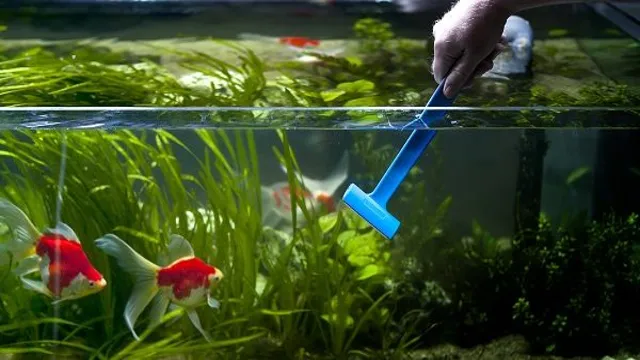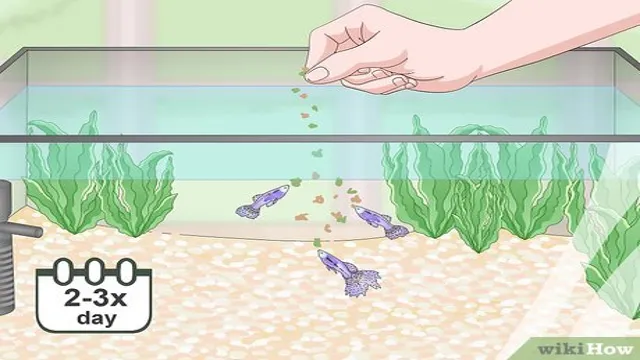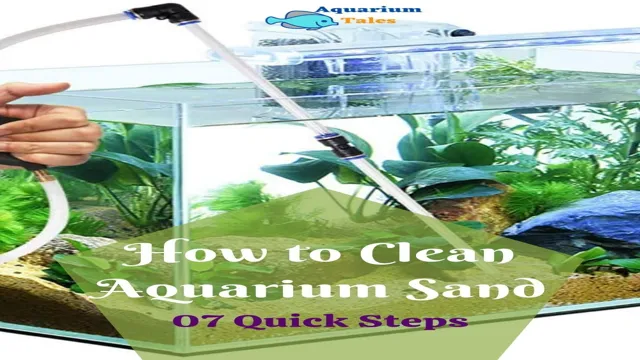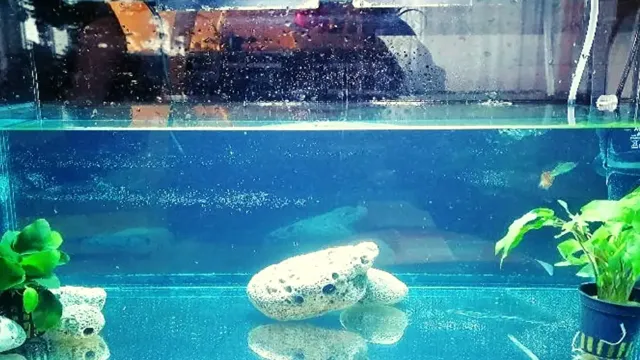How to Clean Aquarium Water Without Filter: Tips and Tricks

Keeping your aquarium clean is crucial to ensure the health and well-being of your fish. While most aquarium owners invest in filters to maintain the water quality, there are times when it may not be possible to use one. Perhaps the filter has malfunctioned or broken down, or you may be dealing with a power outage.
Whatever the reason may be, the question on your mind is, can you clean your aquarium water without a filter? The answer is yes, you absolutely can! In this article, we will explore a few simple techniques that you can use to keep your aquarium water clean without using a filter. So, let’s dive right in!
Determining the Type and Size of Your Aquarium
If you’re wondering how to clean aquarium water without a filter, there are a few things you can do. First, make sure you’re not overfeeding your fish or allowing uneaten food to accumulate in the tank. This can quickly lead to bacterial growth and poor water quality.
Second, you can perform regular water changes to keep the water fresh and remove debris from the bottom of the tank. Finally, consider adding live plants to the tank. These can help to naturally filter the water and remove harmful substances.
When determining the size and type of aquarium you need, consider the number and size of fish you plan to keep, as well as the space you have available for the tank. It’s also important to research the specific care requirements of the fish you choose, as different species have different needs when it comes to water quality and temperature. By taking the time to properly set up and maintain your aquarium, you can ensure a healthy, thriving environment for your fish to enjoy.
Assessing the Water’s pH Level and Chemistry
When it comes to setting up an aquarium, one of the biggest decisions you’ll need to make is determining the type and size of your tank. Before you even start thinking about adding fish or decorative items, you need to consider what type of aquarium you want. Do you want a freshwater or saltwater tank? Will it be a community tank with multiple species or a tank with just one or two dominant species? The type and size of your tank will affect the water chemistry and filtration needs, as well as the types of fish and plants you can keep.
A smaller tank may be easier to manage, but a larger tank will offer more space for your aquatic friends to swim and a greater opportunity for natural processes to help maintain a healthy environment. Ultimately, the decision should be made based on your personal preferences, budget, and level of experience. Whether you’re a beginner or an experienced aquarist, make sure to do your research and choose the type and size of your aquarium wisely to ensure the best possible living conditions for your underwater pets.

Measuring Water Temperature and Oxygen Levels
When setting up your aquarium, it’s important to determine the type and size that best fits your needs before measuring the water temperature and oxygen levels. Consider the fish and plants you want to keep and how much space they require. Some species need more room to swim and thrive than others, so make sure to research their unique needs beforehand.
Additionally, consider the aesthetic you’re going for and the space you have available. Once you’ve chosen the ideal aquarium, you can begin measuring the water temperature and oxygen levels. Water temperature is crucial for ensuring the health and wellbeing of your aquatic pets, as it can affect their metabolism, immune system, and overall health.
Oxygen levels are also essential, as fish require oxygen to breathe. By paying attention to these factors, you can create a thriving aquatic environment that both you and your pets will love.
Changing the Water Regularly
If you don’t have an aquarium filter, you’ll need to change the water regularly to keep your fish and the tank clean. One way to do this is to remove about 20-30% of the water each week or every two weeks, depending on how many fish you have and how much they eat. You can do this by using a gravel cleaner or siphon to vacuum up the debris and waste that has accumulated on the bottom of the tank.
Make sure to also clean and rinse any decorations or plants before returning them to the tank. When adding new water, make sure to use a water conditioner to remove any chlorine or other harmful chemicals that may be present. Monitoring the pH and temperature of the water is also important to ensure a healthy environment for your fish.
While it may require a little more effort than having a filter, changing the water regularly can help to keep your tank and fish healthy and happy.
Understanding the Importance of Water Changes
Keeping the aquarium environment clean and healthy is paramount to the wellbeing of aquatic life. One way to achieve this is by regularly changing the water in the tank. Water changes significantly help to remove built-up waste and toxins which can be detrimental to the fish and other aquatic pets.
Even with a good filter, organic waste and other pollutants can build up to harmful levels. Therefore, changing a portion of the water at least once a week is essential to keep the environment clean and fresh. Additionally, replacing the water also replenishes essential minerals and nutrients that are necessary for the survival of aquatic life.
It’s vital to note that while changing the water, it’s crucial to match the temperature, pH level, and salinity of the new water with the old water to prevent adding more stress to the aquatic pets. Changing water is particularly important in sensitive fish species and breeding setups since a lack of water changes can cause breeding problems and increase the likelihood of various diseases. Thus, changing the water regularly is indeed the easiest way to reduce stress levels and improve the health of aquatic life in freshwater and saltwater aquariums.
Preparing Fresh Water for the Aquarium
Changing the water regularly is an essential part of maintaining a healthy and thriving aquarium. When you have a fish tank, it’s essential to remember that fish produce waste, just like any other living creature. This waste can quickly build up in the water and become toxic to your fish, so it’s crucial to change the water regularly to keep the environment clean and healthy.
Depending on the size of your aquarium and the number of fish you have, you may need to change the water every one to two weeks. You’ll also need to add fresh water to replace the water you’ve removed. When doing so, make sure you add a water conditioner to remove any harmful chemicals or impurities that may be present in your tap water.
By changing the water regularly, you’ll help ensure that your fish have a clean and healthy environment in which to thrive.
Removing Old Water and Debris from the Tank
To keep your aquarium clean and healthy, changing the water regularly is essential. One of the most important aspects of this process is removing all of the old water and debris from the tank. This will help prevent the buildup of harmful chemicals and bacteria that can harm your fish.
To get started, turn off all equipment and remove any plants or decorations that may interfere with the process. Then, use a siphon tube or a gravel vacuum to remove the old water and any debris that may have accumulated on the surface of the gravel. Be sure to get as much of the old water out as possible, as leaving too much behind can lead to issues like high levels of ammonia and nitrites.
Once the old water has been removed, give the tank a thorough cleaning. Scrub the sides and bottom of the tank with a gentle aquarium-safe cleaner, being careful not to scratch the glass. Rinse everything well with fresh water and refill the tank with clean, treated water.
By taking the time to remove old water and debris from your aquarium, you can ensure that your fish and other aquatic life remain happy and healthy. So don’t neglect this important step in your regular aquarium maintenance routine!
Using Live Plants and Natural Filtration
Are you looking for a natural way to keep your aquarium clean without relying on a filter? Look no further than live plants and natural filtration. Adding live plants to your aquarium not only adds beauty, but also provides a natural way to filter the water. Plants absorb nitrogen compounds like ammonia and nitrates from the water, which helps to keep the water clean and healthy for your fish.
Another way to naturally filter your aquarium is by using a substrate like sand or gravel. Beneficial bacteria in the substrate will break down fish waste and other organic matter, keeping the water clean. While it may take a bit more effort and maintenance to rely solely on live plants and natural filtration, it can be a rewarding and sustainable way to keep your aquarium clean and healthy for your fish.
Give it a try and see the difference for yourself!
Choosing Appropriate Aquatic Plants for Your Aquarium
When it comes to creating a healthy and beautiful aquarium, live plants are more than just decoration. They play a vital role in maintaining a natural ecosystem by helping to filter the water, remove toxins, and provide oxygen for the fish. But choosing the right aquatic plants for your aquarium can be challenging.
One essential consideration is the lighting requirements of the plants. Some species require high-intensity light, while others prefer lower levels. Another factor is the type of plant: floating, rooted, or mosses.
Each has its unique benefits and disadvantages. For instance, floating plants like water lettuce provide excellent shade and cover for your fish, whereas rooted plants like Amazon swords help to extract excess nutrients from the water. Adding live plants to your aquarium also requires some maintenance, such as trimming and pruning to ensure they do not overgrow or take over the tank.
By choosing the appropriate aquatic plants, you can improve the health of your fish while creating a stunning underwater landscape.
Learning How Plants Filter Water Naturally
If you’re looking for a natural way to filter water, why not turn to the power of plants? Live plants can be an effective tool for removing impurities from water and creating a healthier, more natural environment. By using natural filtration, you can avoid costly and potentially harmful synthetic chemicals that can harm the environment. Live plants can remove toxins such as nitrate, ammonia, and phosphorus from the water, and can even help to reduce the risk of algae growth.
They also add oxygen and promote the growth of beneficial microorganisms that can help keep the water healthy. So whether you’re looking to create an eco-friendly aquarium or want to improve the quality of your outdoor pond, using live plants and natural filtration can be a great solution.
Avoiding Overfeeding and Overcrowding
Cleaning aquarium water without a filter can be accomplished by several methods. One of the most important things to remember is avoiding overfeeding and overcrowding. When you overfeed your fish, it can leave excess food particles in the water, leading to bacterial growth.
Overcrowding can also result in poor water quality as it leads to increased waste production. Another effective method is regular water changes. It is recommended to change 10-20% of the water every two weeks or so, depending on the size of your aquarium.
This helps to remove harmful toxins and debris from the water. Another alternative is to use live plants in your aquarium. Plants help to absorb and filter out harmful substances from the water, providing a natural way to keep your water clean and healthy.
By implementing these methods, you can maintain good water quality in your aquarium without using a filter.
Feeding Your Fish in Moderation
Feeding your fish in moderation is essential to keeping a healthy and thriving aquarium. Overfeeding and overcrowding your aquarium can quickly lead to problems with water quality and stress for your fish. When it comes to feeding, it’s important to give your fish the appropriate amount of food based on their size and dietary needs.
A good rule of thumb is to feed your fish small amounts two to three times a day instead of one large feeding. This will ensure that your fish are getting the nutrients they need without creating excess waste in the water. In addition to proper feeding habits, make sure that you are not overcrowding your tank.
Overcrowding can lead to competition for food and resources, as well as increased waste and stress on your fish. Consider the size and needs of your fish when adding new members to your tank. By following these tips, you can keep your aquarium healthy and your fish happy for years to come.
Understanding How Overcrowding Can Affect Water Quality
Overcrowding can have a significant impact on the quality of water in your aquarium. While having a lot of fish in your tank can be visually appealing, it can quickly lead to an accumulation of waste that can be harmful to your fish and plants. One of the best ways to prevent overcrowding is to avoid overfeeding.
When you feed your fish too much, they produce more waste, which can quickly build up in the tank. Additionally, uneaten food can decompose and create harmful toxins. Another way to avoid overcrowding is to carefully consider the size of your fish and the size of your tank.
While it may be tempting to add more fish to a smaller tank, it can quickly lead to issues with water quality. By paying attention to the number and size of your fish, you can help to ensure that your aquarium remains a healthy and thriving environment for your aquatic friends.
Conclusion
Well, dear fish-keeping friends, if you’re brave enough to attempt cleaning your aquarium water without a filter, you’ll need to get your hands dirty. Literally. Utilize natural methods such as live plants, snails, or shrimp to consume the waste.
Regular water changes and scrubbing the decor will also go a long way. But if you’re feeling adventurous and want to test your skills, just remember: cleanliness is next to fishliness!”
FAQs
What are some natural solutions for cleaning aquarium water without a filter?
Some natural solutions include adding live plants, using an air stone for oxygenation, and performing regular partial water changes.
Can I use chemical additives to clean my aquarium water without a filter?
Yes, you can use chemical additives such as activated carbon or a water conditioner to detoxify harmful chemicals and impurities in your aquarium water.
How often should I perform partial water changes to maintain clean aquarium water without a filter?
To maintain clean water without a filter, it’s recommended to perform partial water changes of 10-20% of the total volume weekly or every other week.
What are some common mistakes to avoid when cleaning aquarium water without a filter?
Common mistakes to avoid include overfeeding your fish, overcrowding your tank, and leaving uneaten food and debris in the water for too long.
Can I use a sponge or filter media to clean my aquarium water without a filter?
Yes, you can use a sponge or filter media to physically filter out debris and waste from your aquarium water, but it will still require regular cleaning and maintenance.
Do live plants help to clean aquarium water without a filter?
Yes, live plants can help to naturally filter and oxygenate your aquarium water, reducing the need for a traditional filter system.
How can I prevent algae growth in my aquarium when cleaning the water without a filter?
Some ways to prevent algae growth include reducing the amount of light exposure, avoiding nutrient-rich foods, and using algae-eating fish or snails.






